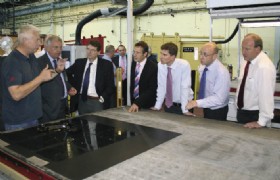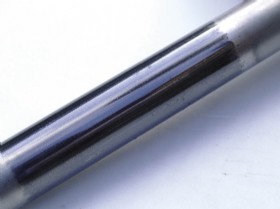Does your packing set really need end rings?





A - Graphite adhesion to the valve stem, after as little as 30 operating cycles. This caused significant juddering during operation, and would get worse with time.

B - Here the low flow fugitive emissions grade packing has “treated” the shaft. This has given a smooth grey patina, and the stem moved smoothly with no pick-up of graphite on the surface.
Traditionally, packing sets have often comprised die-moulded expanded graphite intermediate rings (sometimes of special non-square profiles), with a braided carbon yarn end rings. Many people have long thought of these as “wiper” rings to remove graphite from the stem, or as some kind of anti-extrusion ring, but is this really the case?
They say a fool can ask more questions than a wise man can answer, so with that in mind, let me play the fool (no change there then...) and ask you to think about a few things with the following questions...
1) Firstly, have you ever tried using a graphite packing set without the end rings on a gate or globe valve for instance? – If so then what are your actual experiences?
2) Did you then operate the valve a number of times, and if so did it make a squeaking noise and vibrate or judder during operation?
3) Did the graphite actually "extrude" in the classical sense, or did particles stick to the stem, "plating" it with graphite (see photo A)
4) Have you ever used a well tried and tested fugitive emissions grade of packing (either one that does or does not use end rings)? What happened in this case? Did it colour the stem slightly to a grey patina, without the graphite particles sticking and giving this plating effect? See photo B.
5) Are you sure the carbon yarn ends rings were wiping the graphite off the stem? Could it be that they were wiping a small amount of boundary layer lubricant onto the stem, which stopped the graphite from picking-up in the first place?
6) How many of you may have fitted the traditional combination packing sets into butterfly or ball valves? Of course the stem does not pass through the end rings here, so do they really have any specific purpose?
We have seen butterfly valves for example, fitted with combination sets, where they have failed an emissions test after only a few hundred cycles at most, with erratic operation due to adhesion of the graphite rings. The braided end rings maybe serve as "wiper" to keep out foreign matter (paint, rust etc.) on-site, but they don’t appear to contribute to the actual sealing. If you were to fit a set comprising only the braided carbon end rings and do a gas test, what sort of leak rates would you expect?
At elevated temperatures, is the problem of adhesion and sticking less of a problem than at ambient? It seems that the worst case is an ambient temperature test using a dry gas as a test medium. However, significant thermal cycling rapidly leads to increased emissions and leakage due to expansion-contraction effects of the stem. Thus, does your design of follower and gland stud arrangement, along with your preferred packing, have sufficient resilience to accommodate these potential changes?
The question is whether the use and purpose of carbon yarn end rings has been misunderstood for so long. If reliability is simply a function of boundary layer lubrication, then why not make a hybrid packing, putting the lubrication in the graphite sealing rings where it is actually needed. Obviously the tribology of the stem itself needs to be considered, and the surface finish needs to be rough enough to be coated as described above. A highly polished stem such as might be used with a PTFE chevron seal, may not work effectively with a hybrid packing.
James Walker launched such a packing in 1997, and it has survived countless tests on various emissions rigs to a number of test protocols including TA Luft requirements, in-service valves (both rotary and rising) and the API 607 fire test. There are now at least 3 sealing materials available based upon graphite with improved performance over traditional combination sets. These are simply used by themselves and of course do not require end rings.
James Walker, Tel: 01900 823555

| Telephone: | 01270 536000 |
| Email: | sales.uk@jameswalker.biz |
| Website: | www.jameswalker.biz |
| More information on the James Walker BVAA Member Directory Page |
Search related valve / actuator articles: James WalkerIssue 4Seals







-web.jpg)





